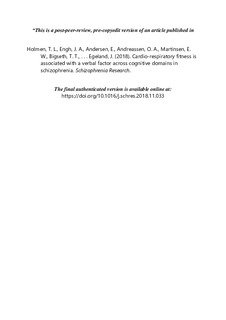Cardio-respiratory fitness is associated with a verbal factor across cognitive domains in schizophrenia
Holmen, Tom Langerud; Engh, John Abel; Andersen, Eivind; Andreassen, Ole Andreas; Martinsen, Egil Wilhelm; Bigseth, Therese Torgersen; Bang-Kittilsen, Gry; Egeland, Jens
Journal article, Peer reviewed
Accepted version
Permanent lenke
http://hdl.handle.net/11250/2589820Utgivelsesdato
2018Metadata
Vis full innførselSamlinger
Sammendrag
Abstract Objective We investigated whether the relationship between cardio-respiratory fitness (CRF) and cognition in schizophrenia is general, or due to selective relationships between CRF and specific aspects of cognitive function. Method Eighty outpatients with schizophrenia spectrum disorders participated. Neurocognition was assessed with the Wechsler Adult Intelligence Scale version 4 General Ability Index (WAIS GAI), the MATRICS Consensus Cognitive Battery (MCCB) and the Emotion in Biological Motion (EBM) test. CRF was assessed with peak oxygen uptake measured directly during maximum exercise using a modified Balke protocol. Partial correlations, controlling for sex and age, were obtained for the perceptual and the verbal indices of WAIS GAI, six cognitive domains of MCCB, and the EBM total score. A factor analysis was conducted on all 15 subtests of the WAIS GAI and the MCCB, and the factors were subjected to separate regression analyses with CRF as predictor. Results Significant, moderately sized correlations were found between CRF and all cognitive domains except processing speed. The correlation appeared strongest for CRF and the Verbal Comprehension Index of WAIS GAI (r = 0.29, p = .005). The factor analysis identified three factors: one speed/attention/executive function factor, one verbal factor, and one perceptual factor. Regression analyses showed that VO2peak explained a significant amount of variance in the verbal factor only (R2 = 0.06, β = 0.329, p = .03). Conclusion The results indicate that the relationship between CRF and cognition in schizophrenia is selectively tied to a modality-specific association with verbal cognitive abilities. These findings have implications for understanding the relation between cognitive factors and physical health in schizophrenia.
